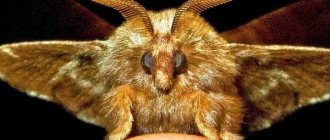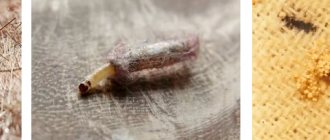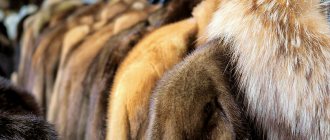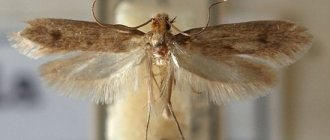How can you tell if there are moths in your house?
The eggs of the pest are very difficult to detect: their length is no more than half a centimeter, and their color is translucent. After a week, moth larvae are born from the eggs, which cause damage to the fur. They eat only the fur, leaving the skin behind. For this reason, bald spots appear. From them you can understand that the fur coat has new owners.
There are also indicators of damaged wool:
- the fur has lost its attractiveness, lumps have formed;
- “cut” fur appeared under the fur coat;
- folds have formed that were not there before;
- the presence of clipped paths;
- Adult moths move around the apartment.
If you notice one of these signs, you should take action immediately, otherwise the clothes will no longer be salvageable.
Signs of infection
Size of food moths and larvae.
It is not difficult to find out that there are moths in the house: fluttering grayish butterflies appear in the kitchen or in food pantries. Most often they can be seen in the evening: insects fly out to bask in the warm radiation of switched on electrical appliances. White caterpillars can be seen on cabinet doors, walls and even ceilings.
Pests lay eggs directly in food products. They do this on purpose: the hatched moth larvae need food. Cobwebs in semolina or flour are also a sign of infection: the adult caterpillar is spinning threads for a cocoon in which it will turn into an adult.
Features of the fur moth
The fur moth is a clay-colored winged insect. Outwardly, it looks like a butterfly, but the fur lover is distinguished by the absence of a proboscis.
Moth larvae are small translucent caterpillars. They live for about 10 months and feed on keratin found in wool. The larvae also chew through any fur that gets in their way. If there are particles of dirt and sweat left on your fur coat, this will certainly attract insects.
A moth (adult) emerges from the larvae. She cannot digest food, so the fur suffers only from moth larvae. However, the moth lays a large number of eggs (about 12 eggs per hour). An adult lives for a month, during which time a whole colony of pests forms in your clothes. Therefore, when putting away a fur coat until the next winter season, it must be thoroughly cleaned.
Preventive measures
Moths are attracted to worn clothes with traces of sweat and sebaceous secretions. This is why holes and abrasions often appear on cuffs, collars and other places in close contact with the skin.
The main preventive measure is frequent washing and cleaning of clothes. Dirty clothes should not be stored in the wardrobe. Attracted by the smell of greasy secretions, moths will ruin not only them, but also clean clothes hanging nearby. Items should be washed frequently or taken to dry cleaning periodically.
Thorough cleaning is also necessary for seasonal clothing and accessories sent for long-term storage: fur coats, jackets, hats, felt boots.
Some dry cleaners offer an additional service: a non-toxic anti-mole treatment that lasts for several months.
Frequent cleaning of the inside of your closet will also help protect your clothes. You need to go through your wardrobe at least once a season. Moths love secluded corners where fresh air and sunlight do not reach.
It is important to frequently rearrange clothes folded in piles: sweaters, cardigans, scarves, warm tights. Clothes on hangers should not hang too tightly; gaps should be left between items for ventilation
When going through your wardrobe, it is recommended to shake things; it is better to do this outdoors.
It is useful to hang woolen items in the hot summer sun. Bright rays negatively affect moth eggs and kill already hatched caterpillars. Frost has a similar effect. Hanging fur coats, coats and suits on the balcony in sub-zero temperatures helps prevent the appearance of clothes moths.
ADVICE! At the end of the winter season, it is better for owners of expensive fur coats, fur coats and stoles to store their items in special refrigerators. This service is offered by large fur salons or dry cleaners.
Covers will help protect clothes - an excellent anti-moth remedy for fur coats. They are needed for seasonal clothing made of drape, mixed fabrics and fur, which moths especially love.
Coats, fur coats, jackets, suits and dresses are stored in covers; they are suitable for transportation and protect clothes from dust.
Products can be purchased at hardware stores (for example, the Raptor brand); the best options for storing valuable mink and sable coats are offered in specialized fur salons.
Products may be impregnated with repellent drugs. Such covers are very effective, but anti-moth impregnations are toxic and not suitable for allergy sufferers.
Soaked products should be protected from children and pets; clothes packed for storage should be placed in the closet so that they do not touch other things. It is advisable to allocate a separate section for it. Impregnated anti-moth covers remain effective for up to 12 months.
An alternative could be a product made from thick cotton or thin plastic. You can make a convenient case yourself.
The style is simple: a rectangle with a sewn bottom and a zipper along the entire length. The size depends on the length of the product; the coat or fur coat should fit into the case freely, without tucking.
Hand-sewn covers must be washed every year after the end of the storage season. They can be treated from the inside with aerosol preparations that repel moths. At home, it is better to use odorless preparations. They irrigate not only the covers, but also the walls of the wardrobe.
The best way to prevent the recurrence of food moths in the home is to be careful when purchasing groceries. It is better to purchase cereals in transparent packages so that you can visually assess their quality. Extraneous inclusions, small lumps, thin cobwebs are signs of food moth infestation.
https://www.youtube.com/watch?v=92AV4XzI4UM
It is advisable to pack all bulk products in hermetically sealed containers so that food moths cannot reach them. Cabinets need to be cleaned regularly in order to promptly get rid of stitched or insect-infested cereals. Kitchen furniture shelves should be wiped from time to time with a strong solution of vinegar, which repels food moths.
Where do moths come from?
Sometimes fur coats in stores are sold already with moths. This is the most common reason for insects to appear in the house. Even purchasing items from expensive stores does not exclude the possibility that the clothes will not contain pest larvae. However, the insect prefers used items, so buying a used fur coat is a risky business; This kind of thing requires careful checking.
Wherever you buy your outerwear, don't immediately put it in your closet. Let it hang on a balcony or other warm or cold room for 2-3 days. Moth larvae cannot tolerate low and high temperatures, so they die in such conditions.
A fur pest can appear not only with a fur coat: be careful when purchasing carpets, furniture and woolen clothes.
In rare cases, fur moths enter the house with the dog. It does not parasitize animals, but can use them as a temporary shelter. If your pet has short hair, there is nothing to worry about: the insect only chooses dogs with long hair.
Prevention
There are a number of recommendations that, if you follow, will protect yourself from infection:
- Store bulk products only in tightly closed containers or jars, as parasites can chew through polyethylene.
- When storing warm clothes in the closet, make sure they are clean. Pests are primarily attracted to stale clothes with the smell of sweat or dirt. It is better to store items in cases or bags. Once every couple of months, clothes should be taken out and aired.
- Things that are attractive to pests, such as fur coats and carpets, are best treated with a disinfectant before storage. Such products usually protect things for several months.
- Ventilate and clean the house regularly. Cleanliness and good air circulation are a hostile environment for pests. When cleaning with a vacuum cleaner, carefully vacuum the cracks in the floor, between baseboards and walls, etc. Larvae are often found in such hard-to-reach places.
- Individuals cannot tolerate typographic smells. So you can safely store things wrapped in newspaper sheets.
How to fight moths?
If you notice a winged fur lover, then don’t hesitate for a minute, because at stake is an expensive product that can still be saved.
Ways to control insects:
- insecticidal method (use of chemicals);
- mechanical protection;
- folk remedies.
Sometimes you need to use several methods at once. These methods are also suitable for preventing the appearance of moths. Let's look at them in more detail.
Insecticidal method
The most effective way to fight if moths eat a fur product. Therefore, you need to start with him.
Advantages of the method:
- does not harm fur;
- easy to use;
- gives quick results;
- inexpensive.
Chemicals are presented in the form:
- fumigator;
- plates;
- tablets;
- aerosol.
If moths have not ruined your fur coat, you need to treat your closet and things with aerosols every two to three weeks. Chemicals are not harmful to health, but may cause an allergic reaction when sprayed. Therefore, you should wear a respirator when using them.
The product must be sprayed on all sides and placed in a special case. When processing, do not ignore folds, pockets and lining material.
A sales consultant at a household chemicals store will help you choose which product is right for you.
Tablets and plates are also an effective method. They contain vegetable oils, so they are not harmful to humans and pets.
You can also buy special gels that come in containers. They need to be laid out or hung in the closet.
Liquid products give quick results and destroy larvae and adults.
Fumigators are recommended to be used only for prevention, because they are not designed to instantly kill insects. But they are very easy to use: the device just needs to be plugged into an outlet.
To ensure that pests are eliminated, take the item to the dry cleaner.
However, even using all of the above methods, some tenacious moth larvae may remain. To achieve maximum results, repeat the procedures several times. We advise you to sometimes do a general cleaning and treat not only the closet with the fur coat, but the entire apartment.
Mechanical protection
This method does not require additional costs. You just need to periodically shake out the fur products and ventilate them.
It is best to perform the procedure when the air temperature is 35–45 degrees Celsius. To improve results, place the fur coat on the seat of a closed car that is in direct sunlight. Leave the clothes for 5-6 hours. Then the product will heat up to the required temperature and the moth larvae will die. You can also take the item outside in severe frost.
It is recommended to combine mechanical protection with chemicals.
Folk remedies
If the moth has already eaten the fur coat, then folk remedies will be powerless. However, they will be an excellent preventive measure. The following will help repel the pest:
- Orange zest or tangerine peel. Moth larvae cannot tolerate the smell of citrus fruits. Dry the peel and put it in your pockets and in the case with the product.
- Geranium and lavender. Pack them in fabric bags and put them in a cover.
- Mint. Dry mint can be placed in the pockets of your fur coat.
- Tobacco. It needs to be scattered at the bottom of the case or cabinet.
We advise you to complete the product with all of the above, then the insect will not spoil the fur coat.
Useful video
If you find an error, please highlight a piece of text and press Ctrl Enter.
Before you send your furry beauty into “summer hibernation,” you need to carefully prepare. This will prevent the appearance of pests.
To do this, it is recommended to carry out the following activities:
- Be sure to clean the product after the end of the season. Existing traces of wear are removed by dry cleaning.
- Fix any problems with the fittings. Carry out cosmetic repairs if necessary.
- Take care of a protective anti-moth cover, which will prevent parasites from getting to the treat. Don't skimp on this accessory. You can purchase covers soaked in essential oils, which moths really don’t like.
- To prevent pests from touching the fur product, create favorable storage conditions, ventilate the product from time to time, and let it breathe.
To prevent moths, not only scented covers are used, but also various tablets, plates, hanging fillers, and stickers. These items are soaked in essential oils, such as citrus, mint, lavender, pine and other repellent aromas. This is not harmful for us, but for insects it is a disastrous remedy. All kinds of aerosols will also help protect your fur item from parasites.
The most common remedy for moths was and remains tobacco. Place it at the bottom of the closet or directly in the fur coat. In addition, bags of lavender, mint, rosemary or geranium are excellent at repelling these insects. You can make such products yourself. Citrus peels are also useful as a preventive measure.
It doesn't matter which option you choose, the main thing is the result.
To prevent the parasite from infesting walnuts or damaging your coat, fur coat hair, or books, it is necessary to carry out preventive measures at regular intervals.
- Next to window openings and ventilation ducts, where the parasite comes from, bags filled with aromatic and natural plants are placed. For food and clothes moths, the odor emitted by geranium or wormwood is unpleasant.
- Peels of lemon and other citrus fruits are suitable for repelling. Since the strong aroma comes from fresh peels, they should be changed periodically.
- A solution containing vinegar or aromatic composition is used to clean kitchen units, cabinets and tables.
- Lavender extract, orange or grapefruit essential oil are suitable for repelling.
- Many people have seen how a moth eats a piece of fur. Therefore, in wardrobes where fur coats or cashmere coats are stored, aromatic herbs and fumigators should be placed.
Carrying out preventive measures is much easier than actively combating spreading pests.
Methods for restoring a fur coat
Even if a butterfly has eaten a fur coat, this does not mean that the clothes should be thrown away. It all depends on the degree of damage. If you took action in time and destroyed the pest, you can correct the fur coat and continue to wear it.
If the affected areas are small in size and hidden from prying eyes, then you can paint over the bald spots. To do this, you will need a felt-tip pen in the color of your fur with a thin tip.
The gap can be decorated with embroidery or a patch. In addition, combining fur products with other fabrics is now in fashion.
A brooch or stole will help hide your bald spot. But this is the case if problem areas have formed near the collar.
Another good way is to cut out the affected area. To do this, you need to carefully cut it and sew up this place. When sewing, do not tighten the thread too much, otherwise the fur will shrink and you will get an uneven seam. Before you start cutting, make sure that the seam will not be visible. If you are far from masterful with a needle, it is better to take your outerwear to a tailor.
If the insect did not leave you a chance for restoration, another option is possible. Fur coats that have been eaten by moths can be altered, for example:
- combine with other fur;
- shorten;
- turn into a vest;
- sew a fur hat.
Do not despair if a moth has eaten a mink coat or other woolen clothing, because you can always correct the situation. But from now on, be careful and take preventive measures.
It’s easier to prevent it than to destroy it
Winter
Owners of expensive furs should carefully study the recommendations on how to store a mink coat from moths. So, it should be remembered that moisture has an adverse effect on the condition of the fur. If you had to get caught in rain or sleet while wearing a fur coat, the first thing you do when you get home is drying it. Moreover, it must be gentle - no hair dryer, gas oven, heater. This is done correctly like this:
- the fur coat is shaken;
- hung on hangers of the appropriate size;
- combed with a special fur brush;
- dry in a quiet position.
Effective means
There are many chemicals and folk methods on how to preserve mink fur and get rid of moths.
Case
You can use the raptor case. The sealed clasp will protect against pests getting inside. In this case, insects that get inside die. The special composition does not harm objects and does not impregnate them with foreign odors. Similar raptor products can be seen in the photo.
Aerosol
Do not spray the product directly onto the surface. This can ruin the fur. In this case, the entire cabinet is treated against moths. One can will be required for the entire season. The procedure is carried out twice a month.
Since the products contain insecticidal components that are harmful to humans, a mask, respirator and gloves are worn.
Children and animals should be removed from the room, as fumes can cause poisoning. After processing, the cabinets are tightly closed.
Such drugs as raptor, aerosol raid, extra mit are distinguished by their effectiveness.
Pills
Such products are produced in special boxes. They are highly concentrated and the smell remains for a long time. The effect of the drug lasts for several months.
The tablet not only destroys moths, but also prevents them from multiplying in the closet and protects against the appearance of eggs. Sections also work. The records are hung inside the furniture, as can be seen in the photo.
Popular questions
When housewives purchase an expensive fur product, they may have various questions about fur moths:
- How to detect moth eggs in a fur coat? It is almost impossible to detect them. Moth eggs are so small that they are difficult to see with the naked eye. They do not exceed 0.5 mm in length. They are usually white in color and oval in shape. Under favorable conditions, larvae appear within 7 days.
- What are the signs of a moth infestation? Since the larvae cut out grooves, folds or wrinkles appear on the product. The larvae also shear off the fur, which leads to the formation of bald patches. In addition, moths are actively fluttering around the room.
- Where else can you find fur moths? Its caterpillars can be found in horseradish, cayenne pepper, saffron, bay leaves, mustard seeds, orris, opium poppy fruits, almonds, and peanut husks. In addition, this parasite can damage stuffed animals, unique zoological objects, tobacco stocks, as well as raw sheep wool.










